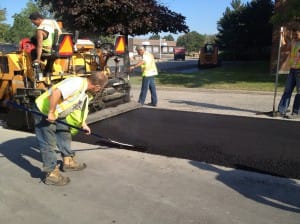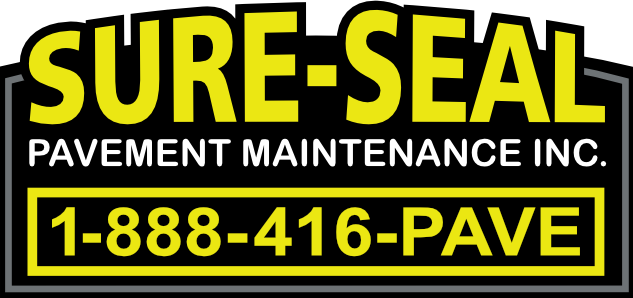
Asphalt is one of the most durable, adaptable, and affordable paving materials on the planet. Although asphalt is primarily used in road construction, it’s a multi-purpose aggregate that can be found in other common products such as roofing shingles, paint, pipe and cable coatings, building waterproofing materials, pool linings, soundproofing materials, newspaper ink, and so much more.
Furthermore, asphalt also happens to be a naturally occurring substance in many parts of the world including the United States, Canada, Trinidad and Tobago, and Venezuela.
When properly installed and maintained, an asphalt parking lot can last anywhere from 20 to 30 years or longer with minimal replacements. Another factor that could impact asphalt longevity is the amount of foot and vehicular traffic your asphalt is exposed to on a daily basis. Even when damages do occur, asphalt repair and overall maintenance is still relatively affordable compared to other paving materials such as concrete.
Asphalt milling is one of the most common repair methods that can conveniently rid your pavement of damages and completely smooth out its surface at minimal cost. What is asphalt milling and how does it work? Keep reading to learn everything you need to know.
What Is Asphalt Milling?
Asphalt milling is a pavement repair method that goes by many names—pavement milling, profiling, cold planing, or just milling. No matter what you call it, the process is essentially the same for various asphalt structures including roads, parking lots, or driveways.
The surface layer of damaged asphalt is removed in order to repair internal structural damages and level out the affected areas. Once the repairs are complete, the surface layer of asphalt that was removed is used to make a new aggregate.
First, the existing asphalt is transported to a processing facility where it’s broken down to the same consistency as gravel. After the asphalt is reactivated, it’s mixed in with other materials including sand, stone, gravel, and binding agents such as bitumen to create a newer and stronger paving material.
In addition to fixing asphalt damages, the process of milling is also beneficial for a number of other reasons. Reclaiming and recycling the existing asphalt surface helps reduce a significant amount of waste that would otherwise end up in our landfills. Financially, it helps businesses and property owners save a great deal of money because it’s cheaper to use old asphalt to create a new aggregate than it is to mix entirely new asphalt.
Asphalt milling also ensures that all major internal structural damages are addressed and thoroughly taken care of before they worsen over time.
When Is Asphalt Milling Recommended/Required?
Asphalt milling goes so much further than simply repairing cracks and potholes. Oftentimes, cracks on the surface of your asphalt pavement are indicative of potentially deeper and more serious structural issues. At the very least, they can lead to serious structural issues if they’re not dealt with posthaste.
Removing the surface layer of asphalt gives contractors the ability to thoroughly investigate the cause of the cracking and fix the issue from the inside out. While some damages call for nothing more than a quick patch job to fill in cracks, that doesn’t necessarily get to the core of the problem. In the long run, failing or neglecting to figure out what’s happening beneath the surface of your asphalt could actually end up costing you a lot more wasted time and money in repairs, not to mention the fact that it could also lead to major liability issues.
If you notice cracking or crumbling asphalt throughout various parts of your pavement, then this could be a sign of much deeper structural damages below the surface such as water erosion or foundational defects. Asphalt milling helps prevent pavement damages such as bleeding and ravelling, which occurs when the aggregate and binder haven’t properly been mixed and start to slowly come apart.
Other damages that call for asphalt milling include:
- Rutting
- Shoving
- Gradient defects
- Uneven pavement
These issues need to be identified and addressed so that they can be properly repaired to prevent potential vehicular damages or injury to anyone who uses your parking lot. As a business or property owner, part of your responsibility is to ensure the safety of everyone who uses your property
Milling your asphalt is a proactive and cost-effective measure that ensures all of the necessary repairs are done properly by professional contractors. Typically, the whole process can be completed in a matter of 24-48 hours depending on the size of the property and the extent of the damages. Professional contractors understand that in business, time is money and that’s why they try to keep downtime to a minimum so that you can resume your operations as quickly as possible.
Keep in mind that the longer you go without performing the necessary repairs, the worse the damages will be and the longer they’ll take to fix when you finally do get around to doing them.
Types of Asphalt Milling
Depending on the type of damages you’re dealing with, there are several different types of asphalt milling processes that can be used. Each method is designed to resolve a specific problem and requires a unique skillset and equipment to get the job done right. Experienced asphalt contractors should be able to examine the damages your pavement has incurred and recommend the appropriate solution.
Fine-Milling
Fine-milling is the process of extracting the damaged surface asphalt and repairing the foundational defects before applying the new overlay or asphalt sealant on top of it. The purpose of this process is to simply refresh the surface layer of asphalt to make it look like new again and eradicate the surface damages. The surface of the asphalt is carefully smoothed and levelled out to create a cohesive surface. Excess asphalt is usually saved for other asphalt restoration processes, which is known as Recyclable Asphalt Pavement (RAP).
Planing
Planing is a slightly more complex asphalt milling process that’s typically reserved for major roadways and large properties. As the name suggests, the purpose of this method is to create a level plane for vehicular, industrial, commercial, and residential use. Commonly employed in resurfacing and repaving projects, planing removes the damaged pavement and uses it to create a new aggregate that’s then used to create a level surface free of slopes, dips, and depressions.
Micro-Milling
Along with removing old, crumbling, and extensively damaged asphalt, micro-milling also extracts old surface treatments from the existing substrate. It unveils a fresher, untarnished asphalt surface that’s easier to work with and more receptive to bonding new surface treatments or overlays.
Only a thin layer (about one inch or less) of asphalt is skimmed off the top of the substrate to achieve smooth pavement gradients throughout. Micro-milling is considered more of a preventative maintenance process than it is to repair internal structural damages. It takes surface defects into account with the sole purpose of removing them and preventing them from getting worse.
What Are the Benefits of Asphalt Milling?
Any form of maintenance is an investment in your business and increases the value of your commercial or industrial property. Asphalt milling is one such process that can keep your pavement looking smooth and clean while increasing its functionality, stability, and longevity for many years to come.
Here are a few key benefits of routinely milling your asphalt.
Affordable Pavement Restoration
No matter which asphalt milling method your pavement requires, the cost will always be relatively low due to the fact that the majority of the material is sourced from the existing surface overlay. Reclaimed or recycled asphalt can help cut the cost of repairs and maintenance significantly, so there’s no reason not to do it. Most contractors also save excess RAP from past projects, which cuts down their costs and results in lower service and labour charges as well.
Asphalt Milling Is the Environmentally-Friendly Option
Asphalt is one of the most recycled and repurposed materials in the world. Excess asphalt that’s not used for a specific job can be reused and incorporated in other products so that it doesn’t end up in landfills. In fact, most road repairs in Canada are performed using reclaimed asphalt.
Correcting Pavement Height and Drainage Defects
New asphalt surface treatments typically entail applying a fresh layer of overlay. While this is a great solution for correcting a plethora of pavement issues, it also means inevitably raising the height of the pavement, which can sometimes lead to drainage defects.
During the construction process, drainage is taken into consideration with the original pavement dimensions in mind. When new surface treatments and overlays are layered on top of the existing asphalt, this can have a negative impact on the existing drainage system, causing blockages, backflow, and even forcing the excess water drainage to be redirected to another part of the pavement. Redirection of excess water can cause it to collect in certain spots, eventually leading to dips, depressions, and erosion—all of which can eventually cause structural problems beneath the surface.
Asphalt milling helps even out the existing overlay without adding multiple layers and causing costly drainage issues.
Sure-Seal Pavement Maintenance Inc. is one of the most renowned asphalt milling contractors in Toronto and the GTA. To ensure optimal results at a low cost, we’ll inspect your parking lot thoroughly and make the appropriate asphalt milling recommendations for you.
Contact us today to book a consultation.
 Asphalt is one of the most durable, adaptable, and affordable paving materials on the planet. Although asphalt is primarily used in road construction, it’s a multi-purpose aggregate that can be found in other common products such as roofing shingles, paint, pipe and cable coatings, building waterproofing materials, pool linings, soundproofing materials, newspaper ink, and so much more.
Furthermore, asphalt also happens to be a naturally occurring substance in many parts of the world including the United States, Canada, Trinidad and Tobago, and Venezuela.
When properly installed and maintained, an asphalt parking lot can last anywhere from 20 to 30 years or longer with minimal replacements. Another factor that could impact asphalt longevity is the amount of foot and vehicular traffic your asphalt is exposed to on a daily basis. Even when damages do occur, asphalt repair and overall maintenance is still relatively affordable compared to other paving materials such as concrete.
Asphalt milling is one of the most common repair methods that can conveniently rid your pavement of damages and completely smooth out its surface at minimal cost. What is asphalt milling and how does it work? Keep reading to learn everything you need to know.
Asphalt is one of the most durable, adaptable, and affordable paving materials on the planet. Although asphalt is primarily used in road construction, it’s a multi-purpose aggregate that can be found in other common products such as roofing shingles, paint, pipe and cable coatings, building waterproofing materials, pool linings, soundproofing materials, newspaper ink, and so much more.
Furthermore, asphalt also happens to be a naturally occurring substance in many parts of the world including the United States, Canada, Trinidad and Tobago, and Venezuela.
When properly installed and maintained, an asphalt parking lot can last anywhere from 20 to 30 years or longer with minimal replacements. Another factor that could impact asphalt longevity is the amount of foot and vehicular traffic your asphalt is exposed to on a daily basis. Even when damages do occur, asphalt repair and overall maintenance is still relatively affordable compared to other paving materials such as concrete.
Asphalt milling is one of the most common repair methods that can conveniently rid your pavement of damages and completely smooth out its surface at minimal cost. What is asphalt milling and how does it work? Keep reading to learn everything you need to know.

